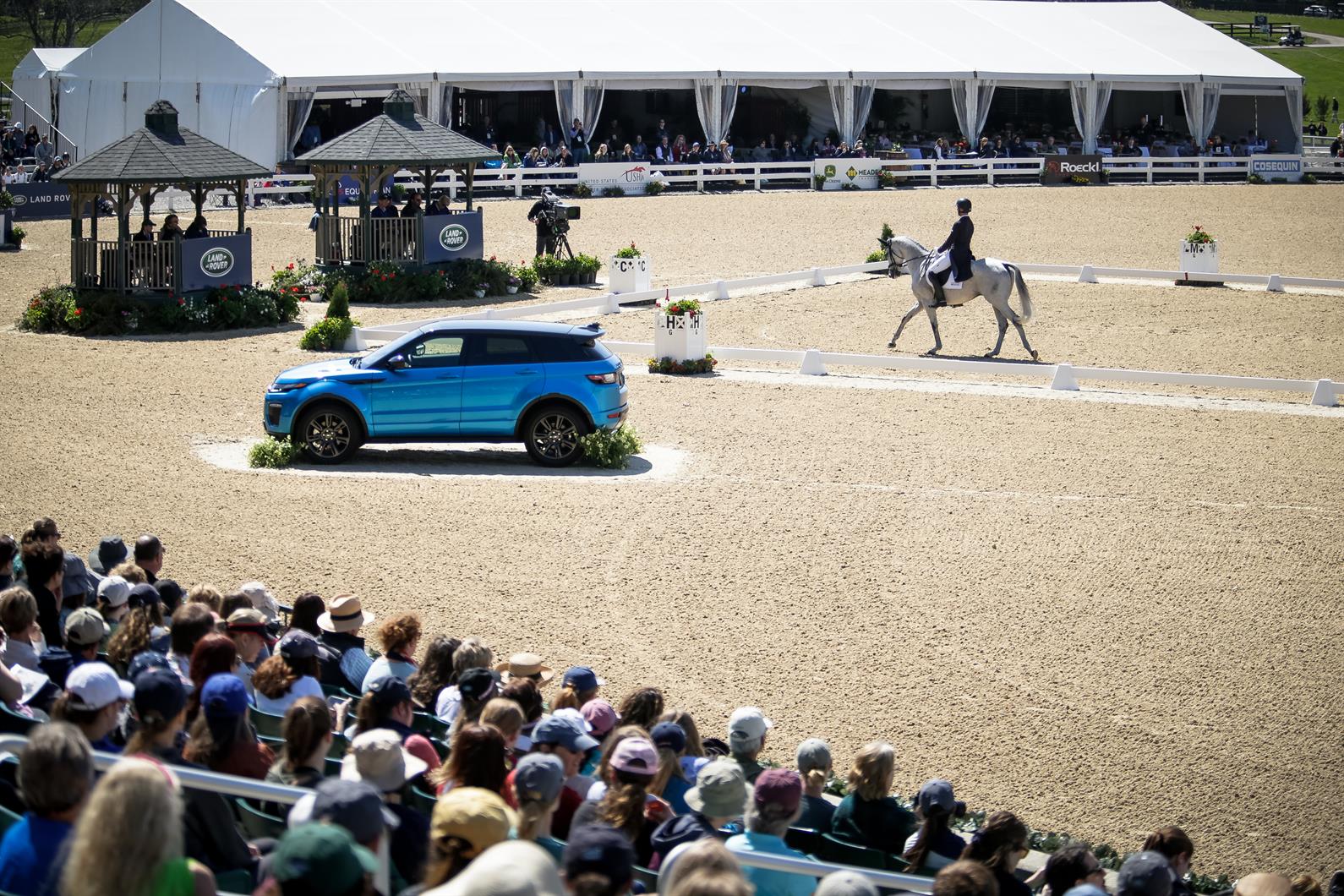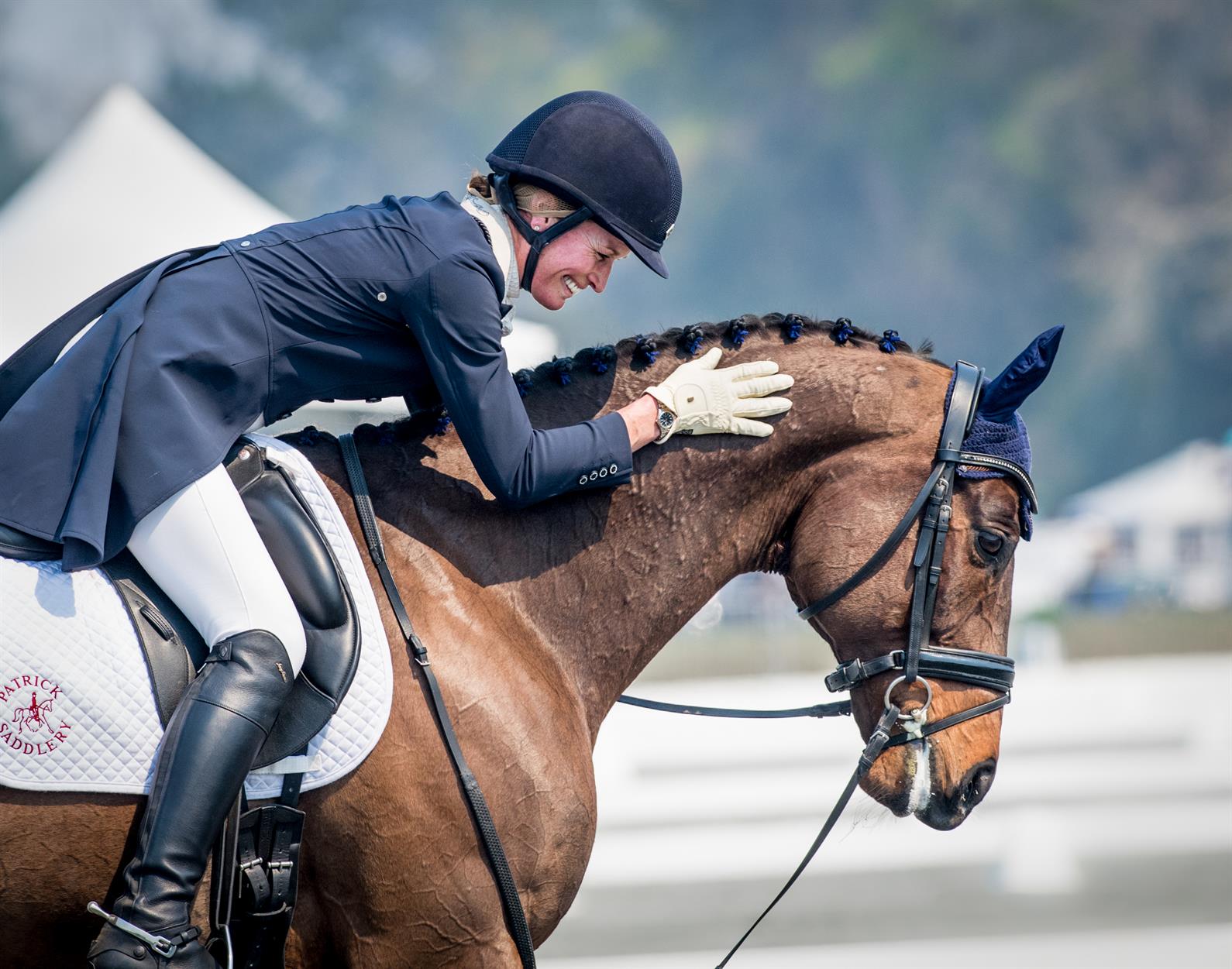
Photo: Taylor Pence/US Equestrian
The dressage phase at the Land Rover Kentucky Three-Day Event presented by Mars Equestrian kicks off Thursday with a dressage ride that isn’t officially judged: the test ride. For eventer Erin Pullen, performing the dressage test ride is an important steppingstone in her horse’s training toward a potential CCI5* career next year. And for the dressage phase’s judges, the test ride is also a key feature of the event, even though it doesn’t play a role in the competition results, because it helps the group of dressage judges calibrate their criteria and expectations together before competitors begin performing the test—FEI Eventing 5* Dressage Test A—for a score. It also provides a test run for each judge with their scribes, who will record the judge’s scoring and comments by hand and on a computer during the competition.
“It’s a chance for the judges 1) to see the test that they’re going to be judging and 2) to be able to confer after the test ride to see if their scores and what they’re looking for work,” explained Jane Hamlin, an FEI Level 3 eventing judge and a USEF ‘S’ judge who has judged at the LRK3DE and the FEI World Equestrian Games™ Tryon 2018. She will judge at this year’s Mitsubishi Motors Badminton Horse Trials in England and at the Tokyo 2020 Olympic Games; she also will serve as president of the ground jury at the Pan American Games in Lima, Peru.
An Opportunity to Confer
“You’re all looking for what the ideal of each movement is and how that horse doing the test ride compares to what your vision of ideal is, and you’re making sure you’re all on the same page about what the essence of that movement is,” Hamlin said. “We’re all looking for the same thing. But even though we’re looking for the same things, that doesn’t necessarily mean we’re all going to have the same scores, because each judge is going to see the test from different locations. But the essence of the movement is clear to all judges.
“The test ride isn’t officially scored, so it doesn’t go up on the scoreboard, and that’s very helpful, because you can get your standards in mind for yourself,” she added. “You don’t really want to change how you judge, because you’re competent and confident at the level you’re judging at. But the test ride lets you see how the test is ridden from the position where you are on the ring. And it lets you have a good discussion with the other judges about what you’re looking for and what is the essence of the movements.
“A test ride also gives you some helpful time with your scribe before you officially judge, because the tests move fast, and you all have to be able to keep up.”
Differences in Perspective
Because the LRK3DE has computer scoring, the dressage judges will have both a scribe to take down scores and comments by hand and a computer scribe, who enters the score for each movement into a computer for real-time recording, including display on the scoreboard.
“The spectators can see all three judges’ scores go up on the scoreboard, and it’s kind of fun to watch how they compare,” Hamlin said.
The judges’ individual scores for each movement often vary, which is largely a function of the different vantage points they have, as they are stationed at different points around the dressage ring rather than grouped in one place. For a diagram of the ring and more about dressage movements, see the USDF Spectator’s Guide to Dressage, produced by the United States Dressage Federation.
For a first-time LRK3DE judge, the test ride also can help settle any pre-competition butterflies.
“Kentucky does an extremely good job, so everything feels very organized: your scribe is experienced, your computer scribe is experienced,” Hamlin said. “You just have to remember that you’re well trained—they wouldn’t ask you to judge there if you weren’t—and that you have a good standard in your mind and a good methodology in your scoring. Kentucky is careful in who they get to judge, and I have to say that the American judges are very well trained.
“Last year was my first year judging there, and it was incredibly exciting,” Hamlin said. “You can imagine what the horses and riders feel, because you feel it, too, when you walk into that stadium with it’s big ol’ grandstand and step into your booth.”
Pullen and Tag Step Up for Test Ride
Eventer Erin Pullen, whose Go Big Eventing program is based near Prospect, Ky., and her 14-year-old Thoroughbred ex-racehorse Tag will get to experience that heady ambience in Rolex Stadium for the first time when they perform the test ride on Thursday morning. That’s why Pullen wanted to be the test rider—to expose Tag to the exciting big-event atmosphere he’ll experience if he returns someday as an LRK3DE competitor. Pullen hopes to qualify Tag for the LRK3DE in 2020.

Photo: Shannon Brinkman Photo
“Each time I get this horse in a big atmosphere in that big arena where he feels claustrophobic, he comes away from the experience so much better,” said Pullen, who got Tag off the racetrack when he was eight. “The next time we go in, he’s like, ‘Okay, I can do this,’ and he lets me ride him and he breathes. I think it’s just so important for him to understand that when he’s in a big atmosphere, it’s going to be okay and just to trust me. My dressage coach Andrea Kroll and I couldn’t be more pleased with how he’s going. I’m thrilled.”
The test ride, which is presented by Hylofit, will also feature a real-time display of key metrics, including the Tag’s and Pullen’s heart rates during the ride, as recorded by the Hylofit wearable heart-rate monitoring system.
Asked whether she’s nervous herself about riding in the Rolex Stadium at North America’s only CCI5* event, Pullen said, “I get nervous that I’ll forget the test! I think I used to be nervous, but now it’s about giving him the best ride I can. But he’s letting me ride each movement instead of my being on a ticking time bomb to see if he’s going to explode at the walk or do a flying change in the counter-canter. Now each movement is getting better and better. He knows how to do everything; it’s just him letting me in when he’s in that environment.”
To help Tag adjust to his first exposure to a five-star crowd, Pullen said the plan calls for “lots of pats, talking to him, keeping him breathing, and keeping him moving. If he gets ramped up, just give him something to do instead of just letting him stare and get star-struck.”
That strategy has worked before, when Tag competed in his first three-star event (now a four-star under the new FEI classification system) two years ago. “He was really tight, but as I went around the arena to warm up, I kept giving him big pats, and I kind of let him move on in the canter and do a little extended canter. Then once he got in that ring, that was the best test we had ever done to that point.”
Pullen, a former racehorse trainer, has plenty of experience with Thoroughbreds both on and off the track. She found Tag—a Texas-bred gelding by Worthingtonhills who made 46 starts at the track—in 2013, thanks to veterinarian Dr. Heather Craven. Craven had known Tag, then eight, since his two-year-old season and, as he aged, she followed his progress through the lower-level claiming races. Along with Tag’s breeder and former trainer Bart Evans, she arranged to buy him privately for $500, then sent him to Pullen as a resale prospect.
When Pullen first saw him she was thrilled. “This horse was stunning,” she said. “He was bright-eyed, bushy-tailed, and with the kindest eye you’ve ever seen. I got on him the next day, and then I called her and said, ‘How much do you want for him?’”
Craven replied, “Nothing. He’s yours.”
“He’s allowed me to go on this journey,” Pullen said of Tag. “I love that these horses always give, and they always try. They’re just always there for you, no matter what. I brought Tag up all the way from beginner novice, and now he’s my first advanced horse. He’s allowed me to travel the country and do things I never thought possible. I’m so thankful for him.”
To see the dressage test’s movements, click here.
This article is original content produced by US Equestrian and may only be shared via social media. It is not to be repurposed or used on any other website aside from USequestrian.org.


